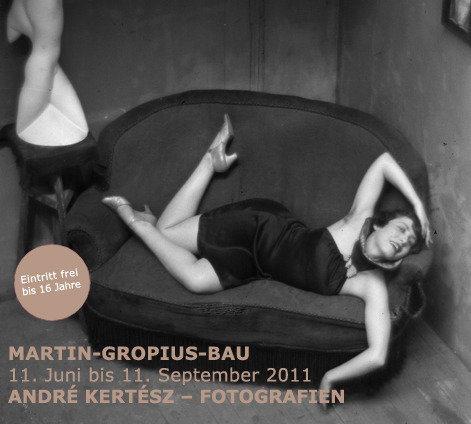Andre' Kertesz
dal 9/6/2011 al 10/9/2011
Segnalato da
9/6/2011
Andre' Kertesz
Martin Gropius Bau, Berlin
Photographs. Kertesz was one of the great masters of photography. With pictures like Underwater Swimmer (1917) or Fork (1929) he made photographic history, while his Paris nocturnes had a seminal influence on his fellow artists, such as Brassai or Henri Cartier-Bresson. He became well-known for his outstanding formal compositions and the surreally inspired poetic works in which he captured apparently simple things and situations.

André Kertész, who as Andor Kertész was born in Budapest into a middle-class Jewish family on 2 July 1894, dreamed of being a photographer even as a child. At the age of 18 he bought his first camera, an ICA Box for use with 4.5 x 6 cm plates. The photo of a sleeping boy dates from this early phase. During his military service in the Austrian-Hungarian Army he documented in laconic images the everyday life of the soldiers: the long marches, the waiting in the trenches, the forlornness of the individual. Wounded in September 1915, he took the famous photo “Underwater Swimmer” while recuperating in Esztergom in 1917. The optically distorted body covered with light reflections seems to anticipate later works. A decade was to pass before the aesthetic effects of reflection were to become popular at the Bauhaus.
After the war Kertész, who worked at the stock exchange, spent his leisure photographing quotidian motifs, like his brother Jenö practising sport, but Budapest did not offer a suitable setting for his artistic ambitions. In 1925 he decided to go to Paris, thus joining the large group of Hungarian artists and photographers – like László Moholy-Nagy, Robert Capa, Germaine Krull and Brassaï – who, after the disintegration of the Austrian-Hungarian Monarchy and the crushing of the Hungarian Soviet Republic, left Hungary in the 1920s and emigrated either to Paris or Berlin.
In Paris Kertész soon made contacts among the artistic avant-garde of Montparnasse: Piet Mondrian, Fernand Léger, Ossip Zadkine and Alexander Calder. In this period he did numerous photographic portraits in postcard format. Strolling through the great metropolis Kertész took photographs of Paris in the streets and parks, on the rooftops and on the banks of the Seine. He saw photography as a visual diary, as an instrument for describing life: “I interpret my feeling at a given moment. Not what I see, but what I feel.”
His close-up shots and bird’s-eye views, his eye for the geometrical structure of space, as well as for shade, reflections and silhouettes, soon brought him recognition. In 1927 the Galerie Au Sacre du Printemps put on the first major show of his work, and in 1929 he took part in the international exhibition “Film und Foto” in Stuttgart and Berlin. In 1928 Kertész began to work with a Leica, the first miniature camera. In the following years “VU” published more than 30 photo essays by him. In 1933 he produced the unusual series entitled “Distortions”, in which female figures distorted by mirrors lead a life of their own between caricature and eroticism.
He also published books such as “Enfants” (1933), “Paris vu par André Kertész” (1934), and “Nos amies les bêtes” (1936). That same year Kertész accepted an offer from the Keystone Agency and moved to New York, but he soon cancelled the contract and went freelance.
His time in the USA was initially marked by difficulties in making ends meet, and in 1949 he accepted a post (which he kept until 1962) for the magazine “House and Garden”. On a trip to Paris in 1963 he rediscovered a large number of his negatives, which inspired him to new artistic activity and brought him international recognition. In 1964 he exhibited at the Museum of Modern Art in New York. In his last creative phase, and particularly after he was no longer able to leave his apartment, he took photos of Washington Square from his window. In his book “From my Window” (1981) he published Polaroid shots of finely composed still lifes showing him still to be a master of light with the simplest of implements.
When André Kertész died on 28 September 1985, he left an archive of 100,000 negatives.
Organizers: Berliner Festspiele. An exhibition of Jeu de Paume, Paris, in association with the Martin-Gropius-Bau, Berlin.
Press contact: Tel.: +49 (0)30-25486 236, Fax: +49 (0)30-25486 235
E-Mail: presse@gropiusbau.de
Public Relations: Ellen Clemens, Tel.: +49 (0)30-25486 123
Fax: +49 (0)30-25486 107, E-Mail: organisation@gropiusbau.de
Press Conference Friday, 10th June 2011, 11 a.m.
Martin-Gropius-Bau, cinema
Present at the press conference: Annie-Laure Wanaverbecq, Curator of the exhibition
Michel Frizot, Curator of the exhibition
Gereon Sievernich, Martin-Gropius-Bau, Director
Opening Friday, 10th June 2011, 7 p.m.
Martin-Gropius-Bau
Niederkirchnerstr. 7 D-10963 Berlin
General opening hours:
Wed - Mon, 10 a.m. - 8 p.m., closed on Tue
Open first Tuesday after Whitsun (14 June)
Special opening hours: 14.5.-30.5.2011, 10 a.m. -10 p.m., closed on Tue



